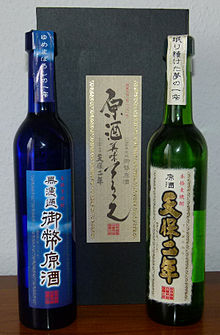Shochu
Shōchū ( Japanese 焼 酎 , literally: " Brandy ") is a high-percentage alcoholic drink obtained by distillation that is traditionally made in Japan . Its manufacture was imported to Japan from China or Korea. The home of Shōchū in Japan is on the island of Kyūshū in Kagoshima . In the English-speaking world, it is often referred to as "Japanese vodka ". Most varieties have around 25 % alcohol by volume , some even up to 43% by volume.
Manufacturing
Shōchū can be made from rice ( 米 焼 酎 , kome shōchū ), but more common is barley ( 麦 焼 酎 , mugi shōchū ), sweet potato ( 芋 焼 酎 , imojōchū ) or sugar cane ( 黒 糖 焼 酎 , kokutō shōchū ). More unusual raw materials are soba (buckwheat), sweet chestnut ( 栗 焼 酎 , kuri shōchū ) and milk ( 牛乳 焼 酎 , gyūnyū shōchū ). The starch source is fermented for several weeks after the addition of molds (Kōji). In the fermentation, a special white Kōji is used ( Aspergillus kawachii ), in contrast, is a black Kōji ( Aspergillus awamori ) for Awamori , a similar spirit of Okinawa used. It is then distilled and the drink is stored for a few months before it goes on the market.
The distilled Shōchū is not to be confused with sake , a rice wine also made using Kōji but not distilled . However, in the south of Kyūshū sake means potato shōchū ( Imojōchū ), as well as Thai rice shōchū , ( awamori , literally: "head of foam") and kūsū (literally: "old drink") in Okinawa .
quality
The very inexpensive Shōchū is also often used in mixed drinks, so-called Chūhai .
There are two classes of Shōchū, Kōrui shōchū ( 焼 酎 甲類 , shōchū kōrui ) is distilled twice or more, so with a higher percentage. The result is almost odorless and tasteless and is mostly used for mixed drinks so as not to mask the character of the other ingredients. Otsurui Shōchū ( 焼酎乙類 , Shōchū otsurui ) or Honkaku ( 本格焼酎 , Honkaku Shōchū ), or "real" Shōchū is the other variety.
The taste of shōchū is usually much less fruity than sake and depends heavily on the raw material used. The taste is often described as "nutty" or "earthy". Imo-jōchū has a distinctive almond aroma . Shōchū is currently booming in Japan, with many younger drinkers preferring it to traditional sake.
designation
In southern Kyūshū , the center of shōchū production, the word sake often refers to sweet potato shōchū ( imo-jōchū ), while in Okinawa it is occasionally, often incorrectly, used for the local alcohol specialties Awamori ( 泡 盛 ) and kūsu ( 古 酒) , lit. "old schnapps"). Prior to April 1983, Awamori was labeled as Shōchū "second class", but is now referred to as "Real Awamori". It is a little different from Shochu. Awamori is also a distilled rice schnapps, but is made from the long-grain, broken indica rice from Thailand , not the short-grain Japonica rice used for shōchū.
In Korea Shōchū is also known as Soju , in China as Shaojiu .
particularities
In Japan , depending on the season and personal taste, shōchū is usually mixed with ice ( shōchū rokku , from "shochu on the rocks") or drunk with hot water ( お 湯 割 り , oyu-wari ). It is also mixed with oolong tea or fruit tea (e.g. grapefruit). Shōchū is available from supermarkets, liquor stores, and grocery stores in Japan.
Shōchū is also used for the mixed drink Chuhai ( chūhai 酎 ハ イ , short for shōchū highball 焼 酎 ハ イ ボ ー ル ). A chūhai consists of shōchū, soda , ice and a (fruit) aroma. Lemon, grapefruit, apple and ume are particularly popular. Canned Chūhai is sold in grocery stores and vending machines.
Shōchū became better known through a regular consumer, the Japanese Shigechiyo Izumi , who was temporarily thought to be the oldest person and drank Shōchū daily. This led to assumptions that Shōchū promote longevity.
swell
- Okinawa Prefectural Government, "Awamori", Okinawa: Cultural Promotion Division, Okinawa Tourism and Cultural Affairs Bureau, 1996.
